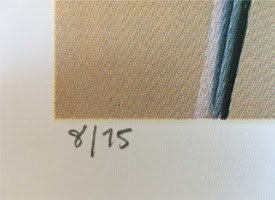What You Need to Know About Buying Limited Edition Art Prints
If you’re looking into buying a
limited-edition print, whether you’re starting out your collector’s journey or are just really interested in purchasing a specific piece, edition info may not be the first thing you think about. Of course, if you have your heart set on a particular piece which you know you love, these details might not change your mind. However, knowing a piece’s edition info not only gives you a greater appreciation for the piece; it also gives you a clearer understanding of the piece’s value, the artist, and of the art market in general.
Not sure how to go about buying limited edition art prints? Here are the important factors you will want to consider.
Edition Value
Many pieces of art—whether prints, photography, or sometimes even sculptures—are created in runs. These are multiple original artworks (not a reproduction of an original artwork) using printmaking techniques such as etchings, lithographs, etc. Even though many prints of the piece are made, they are counted by collectors and historians as ‘first edition’ artworks if they are part of a particular set. So, while a piece may not be completely one-of-a-kind, it is still considered unique or rare as part of an original run of prints.
These limited-edition groups of works often retain their value very well, as artists usually destroy the materials needed to create extra copies that are exactly alike, such as photo negatives. That said, popular art can be re-printed for second or third edition runs, or even more if demand is high. These limited editions can also be worth more than a standard replication of a piece.
Print Number
 |
Print Number Example (8/75)
|
Given that editions get less valuable as they go on—first editions are more valuable than second editions, etc.—many assume this also extends to the number of the print. This is the number given to a piece to identify it within the edition. For example, if there are 20 copies in an edition, your piece may be labelled 5/20, or 13/20, or even 1/20. Contrary to popular belief, however, this number doesn’t impact the value as in general modern printmaking techniques don't wear out soft metal plates etc, which resulted in later prints being of lesser quality. In fact, most artists number pieces randomly, not in the order that they’re printed.
Sometimes, the end of the scale (20/20 in our case) can be more expensive, but this is only because galleries tend to list limited edition prints in numerical order. As these run out and stocks run low, demand can lead to higher prices.
Artist Proofs
Limited edition pieces usually also come with artist proofs; look for ‘AP’ or ‘A/P’ in the edition info.
Other kinds of proofs exist too, which are provided by the printer, but artist proofs are more common.
Artist proofs are popular at New Zealand Fine Prints because these are the first prints to be made, and any adjustments to the printing process are made by the actual artist working on these prints. The proofs themselves can be highly collectable—some of them might have notes or marks made by the artist, and this can make them much rarer and more unique.
Explore the world of art today
If you’re interested in edition info, your best course of action is to talk to the gallery or printmaker selling the prints. Here at New Zealand Fine Prints, we have a range of contemporary collectable ltd edition prints, alongside
antique and rare pieces as well as our range of canvas prints,
giclee fine art prints, and more, and we’re happy to answer your questions about the differences between all the different kinds of prints that we stock, whether open or limited edition.
To find out more, get in touch with us, shop New Zealand’s largest collection of prints online today!


